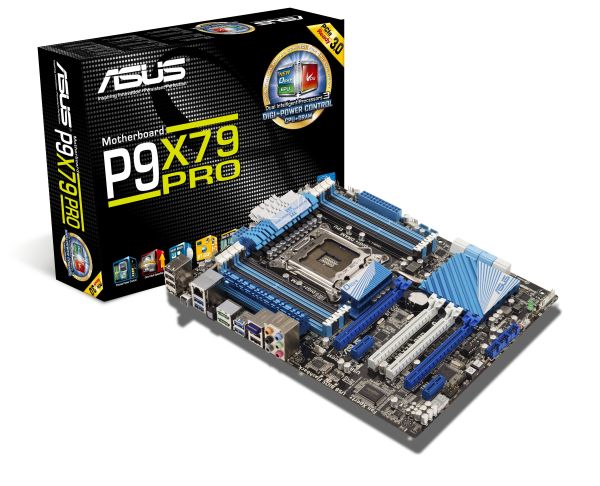Sandy Bridge-E and X79 – The ASUS P9X79 PRO Review
by Ian Cutress on November 14, 2011 3:01 AM EST- Posted in
- Motherboards
- Asus
- X79
Final Words
With a new enthusiast platform, it is easy to get caught in the hype of just how well a processor is when analyzing a motherboard. Part of my job is to communicate what I think about the motherboard to the readers and hopefully provide information as well as a judgment on the product at hand.
So this review has been about X79, and specifically ASUS’ P9X79 Pro. If the past has told us anything, the Pro boards from ASUS have been hot sellers, and I expect X79 will be no different, assuming users will also shell out for the Sandy Bridge-E processors. The P9X79 Pro is expected to retail at $329.99 on release, which to a lot of non-enthusiast users will seem mind blowing that a motherboard could cost this much. But there is method in the madness.
From the outside, as a whole, X79 contains a lot of what an enthusiast user may want from a motherboard – lots of memory channels and lots of PCIe lanes for GPUs being the main plus points here. Downsides are the lack of USB 3.0 native support, the promise of SAS support being removed, no Z68 RST, and the persistence of SATA 3 Gbps ports on Intel’s PCH when AMD can provide six SATA 6 Gbps ports from their FCH.
ASUS have tried to change that, by introducing sets of unique features to the platform. Their SSD caching technology is a welcome side to the platform, USB 3.0 Boost offers that little bit extra beyond the standard X79 specifications from the USB, and BIOS Flashback technology is an ideal feature that in retrospect should have been on motherboards years ago. The board as a whole gives a clear indication of what can be possible after Intel hands a motherboard manufacturer a chipset and the chipset specifications.
Alongside the board’s aesthetics, we have a well featured product on our hands. The P9X79 Pro has six fan headers, all under some of the best controls available on a motherboard; power/reset/clear CMOS buttons; a debug LED; ASUS’ DIGI+ VRM solution for fine tuning; ASUS’ TPU (Turbo) and EPU (Power Saving) processors; a BIOS full of features especially when tuning memory; Bluetooth; and an Intel NIC.
No board has ever been perfect, and the nit picking I have to do here is relatively minor. The ‘per-core’ adjust required for fairness in comparison to other boards was a little peculiar, and in terms of what came with the board, I would have preferred a CrossFireX cable rather than one of the SLI cables, to account for the spacing between the first two recommended GPU slots. At ~$330, a USB 3.0 front panel may have been a good addition too, as well as another NIC.
Hopefully a lot of people who buy this board will enjoy it as much as I have enjoyed reviewing it. For this, I would like to give ASUS, and the P9X79 Pro, a silver AnandTech Editors’ Choice award, for innovation on such a solid product beyond the standard specifications, as well as having the solid hardware and software backbone that users expect in a motherboard.












55 Comments
View All Comments
buildingblock - Monday, November 14, 2011 - link
Amongst all the other goodies, the outstanding feature for me is the BIOS fan control. Well done to Asus, this board has probably the best PWM based fan control yet. Other board makers, particularly GigaByte, please take note.ASUSTechMKT - Monday, November 14, 2011 - link
Thanks so much for the feedback. We have been working hard to consistently improve in the quality of fan controls. Kudos to Ian for taking the time to detail it as well. This is somethign we have to take more time in the development ( Super I/O controller and frmware and software ) but any serious enthuiast can appreciate the additional functionality and increased usability.Thanks again!
jigglywiggly - Monday, November 14, 2011 - link
am i the only one kind of dissapointed? No integrated gpu is lame, also not that much faster.Kougar - Monday, November 14, 2011 - link
Holy moly, $330 for just the Pro?Given the extreme prices involved here, I'd especially like to know the key differences between the Pro and the Deluxe models, and even the Pro and the vanilla model as well.
ASUSTechMKT - Monday, November 14, 2011 - link
DeluxeOffers BT3.0 with Wifi, Additionally USB3, Dual Lan, A more advanced VRM heatsink assembly,
In regards to the pricing it is important to remember many of the additional items incorporated have a higher cost ( such as the hardware required to allow for UEFI flashing with CPU, Memory or a Graphics card this required a hardware level IC, the more advanced super I/O controller with more advanced fan controls for all the headers ) These additional touches add to the total cost of the board.
Kougar - Monday, November 14, 2011 - link
Thank you for the reply!For anyone else curious, after some digging I can say that in addition to the above, P9X79 Vanilla also loses the Marvell controller and associated SATA 6Gb/s ports. The Realtek sound chip also changes from a 898 to the 892, not sure what the difference is. The PWM phase design appears to remain unchanged between the vanilla and PRO models, while the Deluxe doubles the CPU & uncore phases.
Somewhat oddly, the P9X79 also gains a firewire port over the PRO model.
ASUSTechMKT - Wednesday, November 16, 2011 - link
Yes as you go up the boards you will also have more USB 3 (as the PRO has more USB which makes sense as 1394 is a legacy standard). Main reason it is offered on the Standard is that this model is adopted by sometimes business or professionals you still need some legacy connections.In regards to the overall VRM design we use the same high quality dual N mosfet package on all three boards and advanced driver this aligns with the high amperage rated choke. While the "phase" is increased on the Deluxe this only helps to slightly improve balancing of the VRM otherwise the performance for overall power delivery is rated the same. (Although the advanced heatsink design as you move up will help to ensure a cooler operating temperature for the VRM assembly.
Hope it helps!
Filiprino - Monday, November 14, 2011 - link
There was a rumour saying ASUS would release a dual socket LGA2011 motherboard to compete with EVGA SR-3. Any news?Kougar - Monday, November 14, 2011 - link
The board exists, but I haven't seen anything about it so far. Very curious to see it and the EVGA SR-3 compared, even if just to drool over!ASUSTechMKT - Wednesday, November 16, 2011 - link
Sorry cannot comment on that one......